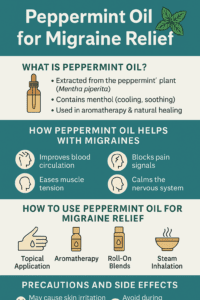Imagine this – you’re going through a busy day, whether it’s at work, running errands, or spending time with family. Suddenly, a pounding pain shoots through your head. The lights seem too bright, every sound feels like a hammer, and you can’t help but shut your eyes. It’s not just a headache – it’s a migraine.
To get relief, many people turn to medications. But what if they don’t always work? Or what if you prefer a natural alternative?
That’s where peppermint oil comes in.
This essential oil isn’t just about a fresh scent—it’s been used for centuries to calm the body and ease discomfort. But does it really help with migraines? Let’s explore how peppermint oil can offer relief, backed by both science and personal experiences.
What is Peppermint Oil?
Peppermint oil is extracted from the Mentha piperita plant, a natural hybrid of watermint and spearmint. It’s rich in menthol, the cooling compound responsible for its refreshing feel and aroma.
Throughout history, this oil has been used in traditional medicine to aid digestion, relieve tension, and manage pain. Today, it’s gaining recognition as a go-to remedy for tension headaches and migraines.
How Peppermint Oil Helps with Migraines
1. Improves Blood Circulation
When applied topically to the temples or neck, peppermint oil stimulates blood flow, which can reduce the pressure that often causes or intensifies migraines.
2. Eases Muscle Tension
Migraines often originate from tension in the neck, shoulders, or jaw. Peppermint oil’s natural muscle-relaxing properties help release that tightness.
3. Blocks Pain Signals
Menthol creates a cooling sensation that can “distract” your nervous system from sending pain signals to the brain—essentially giving you a break from the throbbing.
4. Calms the Nervous System
Peppermint oil’s aroma is known to soothe anxiety, lower stress levels, and support relaxation. Since stress is a major migraine trigger, this benefit is crucial.
What the Science Says
A 2016 study published in the Journal of Pain Research found that a 10% solution of peppermint oil applied to the forehead significantly reduced headache intensity in just 15 minutes. In fact, the results were comparable to taking 1000mg of acetaminophen.
The National Institutes of Health (NIH) also lists peppermint oil as “possibly effective” for relieving tension-type headaches.
How to Use Peppermint Oil for Migraine Relief
Here are safe and effective methods for using peppermint oil:
1. Topical Application
Dilute 2–3 drops of peppermint oil with a carrier oil (such as coconut, almond, or jojoba oil). Massage the mixture into your temples, forehead, and neck.
Note: Never apply undiluted essential oils directly to your skin.
2. Aromatherapy
Add a few drops of peppermint oil to a diffuser. Inhale deeply for several minutes while resting in a quiet, dark room.
3. Roll-On Blends
Ready-to-use roll-ons are great for keeping in your purse or pocket. Roll onto pulse points or temples whenever a headache strikes.
4. Steam Inhalation
Add a few drops of oil to a bowl of hot water. Drape a towel over your head and inhale the steam to ease sinus-related migraines.
How to Choose High-Quality Peppermint Oil
Not all essential oils are created equal. Here are tips to ensure you’re getting a therapeutic-grade product:
-
Look for “100% pure” on the label
-
Check for third-party testing (like GC/MS reports)
-
Avoid synthetic fragrances or additives
-
Choose glass bottles (dark-colored, like amber or cobalt blue)
-
Trusted brands: Plant Therapy, doTERRA, Rocky Mountain Oils, NOW Foods
,
>>> Peppermint Oil check prize on amazon
Safety Tips & Precautions
-
Always perform a patch test before full use.
-
Avoid contact with eyes, mouth, or broken skin.
-
Not suitable for children under 6 or pregnant women without medical advice.
-
If irritation occurs, discontinue use immediately.
Comparing Natural Remedies for Headache
| Remedy | Benefits | Ideal For |
|---|---|---|
| Peppermint Oil | Cools nerves, relaxes muscles | Tension + migraine headaches |
| Lavender Oil | Eases anxiety and promotes calm | Stress-related headaches |
| Chamomile Tea | Reduces inflammation, aids sleep | Insomnia-linked headaches |
| Ginger Tea | Nausea relief, anti-inflammatory | Migraines with nausea |
Real Stories from Real People
“I used to pop pills every time a headache hit. Now, I keep a peppermint roll-on in my bag. It’s fast and natural!” – Emily, 32
“My daughter struggles with exam stress migraines. Massaging peppermint oil onto her temples calms her quickly.” – Jason, 44
When to See a Doctor
While peppermint oil can provide significant relief, it’s important to know when to seek professional help. Talk to a healthcare provider if:
-
Your migraines are frequent or worsening
-
You experience vision changes, numbness, or slurred speech
-
Home remedies don’t offer lasting relief
-
You need to take pain relievers multiple times a week
Essential oils are powerful—but they’re best used as part of a comprehensive care plan, not a replacement for medical diagnosis or treatment.
FAQs
Q: Can I use peppermint oil daily?
Yes, just make sure it’s properly diluted and you’re not experiencing skin sensitivity.
Q: How quickly does it work?
Most users report relief within 15 to 30 minutes.
Q: Is it safe during pregnancy or for kids?
Consult your doctor before using essential oils during pregnancy or on children.
Q: Can I ingest peppermint oil for migraines?
No. Unless directed by a licensed healthcare professional, peppermint oil should not be ingested.
Q: What’s the shelf life of peppermint oil?
Typically 1–2 years if stored in a cool, dark place.
Final Thoughts
Migraines can feel overwhelming—but nature offers gentle, effective ways to ease the pain. Peppermint oil is more than a fragrant oil; it’s a trusted companion for many who suffer from headaches.
Give it a try. One small bottle might just make a big difference in your day.
